


A newsletter for modern marketers.

TRUSTED BY THE WORLD'S SMARTEST MARKETERS
Free ad performance benchmarks every week.

Live webinars and strategy sessions with industry leaders.
Watch all previous episodes on our YouTube channel.
Insider strategies from the smartest brands in ecommerce.
SEE LATEST POSTS:

Cyber Week 2025: A Data‑Driven Look at Performance and Strategy

This article, our associated whitepaper, and the webinar I hosted, are based on Northbeam’s internal proprietary Clicks-Only data.
For DTC brands, Cyber Week 2025 wasn’t just “another record year.” It was a clear signal that peak season is now a strategy game, not a “spend big and hope for the best” game.
Across Northbeam’s customer base, we saw ad spend rise by just over 9% year over year, while revenue grew more than 13%, lifting MER even as first‑time CAC climbed about 8%. In other words: shoppers are still willing to buy, but they’re a lot more selective about when and how they convert.
This blog is a high‑level walkthrough of what we saw across thousands of DTC brands during Cyber Week 2025, and how the best teams are already adjusting their playbooks for 2026.
If you want the full channel‑by‑channel, industry, and company‑size breakdowns, grab the report this blog is based on:
Get the full data set: Download the BFCM 2025: The Report whitepaper for all charts, daily breakdowns, and industry cuts.
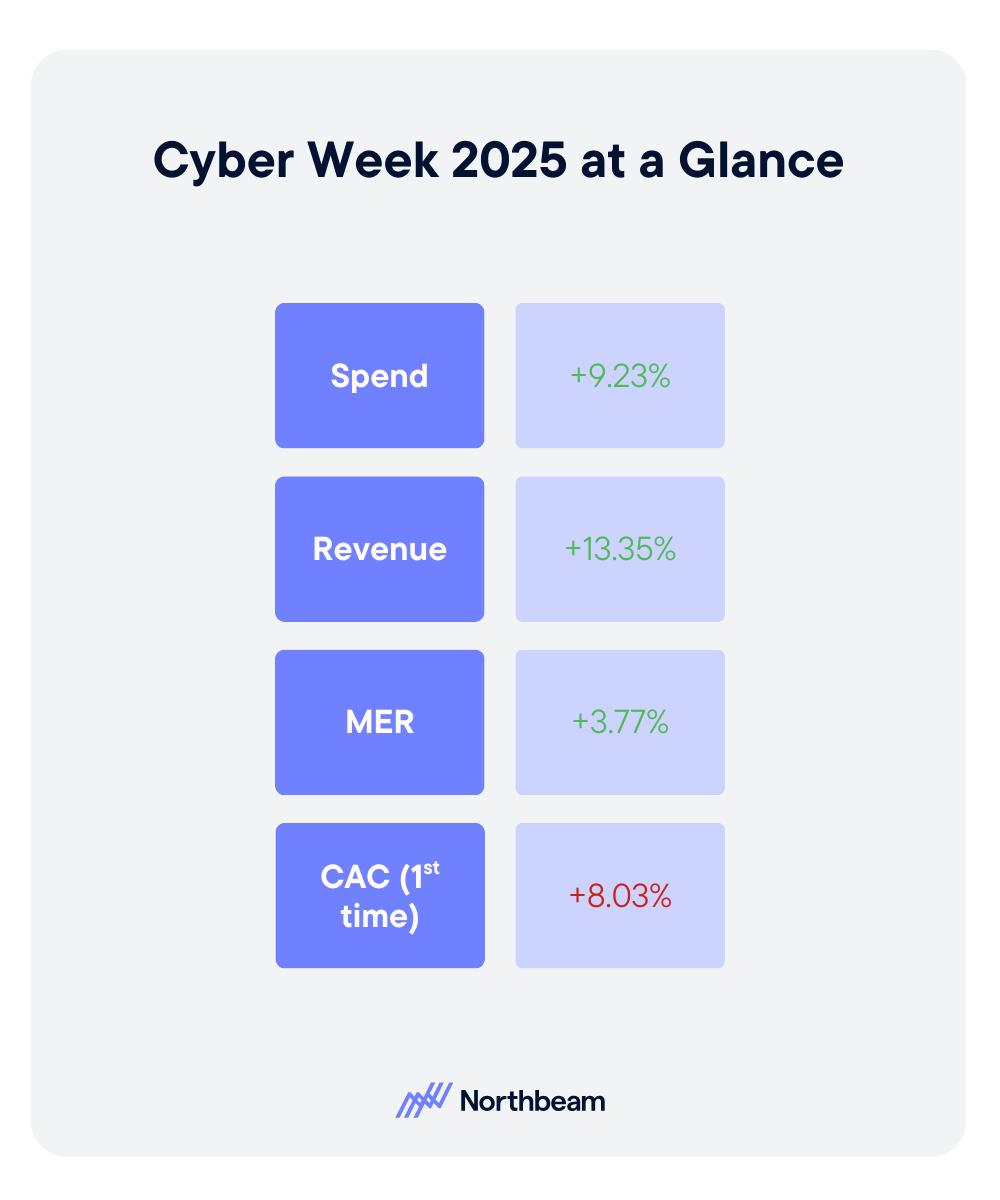
1. The window keeps widening: seed early, harvest late
Long gone are the days of lining up outside a big‑box retailer at midnight. The in‑store moment may have faded, but the online punch of Black Friday/Cyber Monday is absolutely still there, it just starts earlier and stretches longer.
When we looked at the 21‑day run‑up to Cyber Week (Nov 4–24), a few things stood out:
- Brands increased spend in the lead‑up; roughly mid‑single digits overall.
- Revenue in that same period grew a bit faster than spend.
- First‑time CAC jumped sharply, into the mid‑teens percentage‑wise.
Put simply, advertisers were priming the pump. They were willing to pay more to get in front of new customers before the sale, knowing that a meaningful chunk of that demand would only convert once the “real” offers went live.
That’s conversion lag in practice:
Dollars spent early in November convert during the sale itself, sometimes days or even weeks later.
If you only look at 1‑day click ROAS in‑platform, this early‑month spend can look terrible. When you look at it through a multi‑touch, cross‑channel lens, it suddenly becomes clear that your “expensive” pre‑BFCM dollars are actually doing a lot of the heavy lifting for peak week performance.
In the full report: we break down the Nov 4–24 period in more detail and show exactly how spend, revenue, MER, and first‑time CAC moved during those three weeks.
Watch the full webinar I hosted right here!
2. Cyber Week is a week‑long arc, not a single spike
From a distance, Cyber Week still looks like what you’d expect: spend ramps into Black Friday, stays elevated through Cyber Monday, then cools off. But when you zoom in day‑by‑day, the pattern is a lot more instructive.
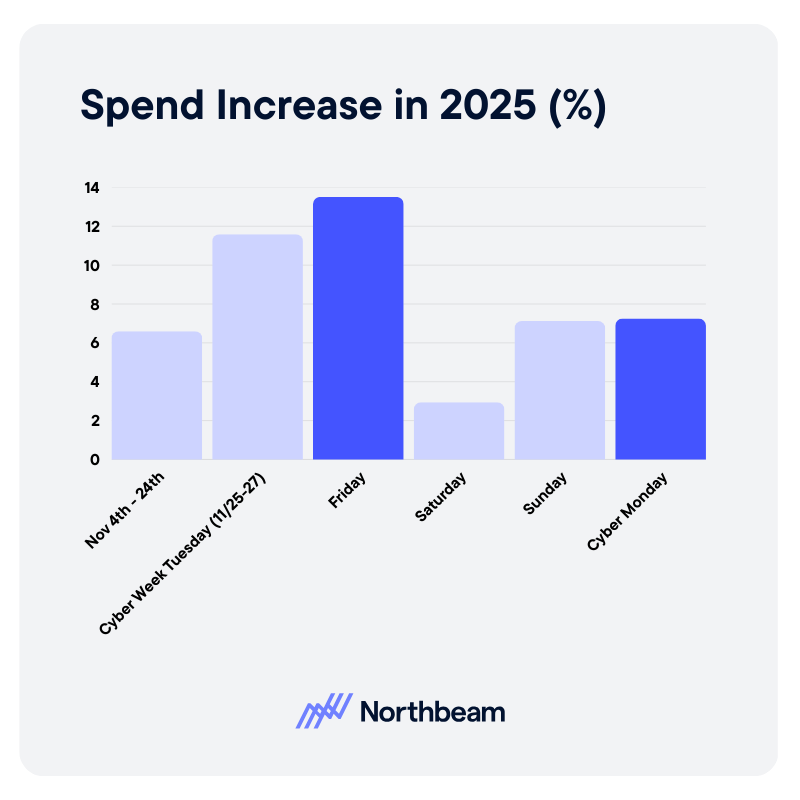
Here’s the simplified version of what we saw:
- Tue–Thu (pre–Black Friday)
Brands ramped into the peak. Spend and revenue both moved up double‑digits vs. last year, MER improved modestly, and CAC started to climb as consumers browsed and waited. - Black Friday
Still the single biggest spend day of the week, but also the point where efficiency compressed the most. MER dipped relative to 2024 while CAC jumped by the mid‑teens as auctions got crowded and everyone piled in at once. - Saturday & Sunday
Many brands pulled back on spend on Saturday, and MER actually rebounded as the most motivated shoppers kept converting. By Sunday, both spend and revenue started to pick up again heading into Monday. - Cyber Monday
Spend re‑accelerated and efficiency improved vs. Black Friday, MER climbed, and CAC rose more modestly. This is the “I’ve been browsing all weekend and I’m finally pulling the trigger” behavior we heard anecdotally across accounts.
This is why we’re pushing clients to stop thinking in terms of “What’s my Black Friday budget?” and start thinking in terms of “What’s my Cyber Week arc?”
Some practical implications:
- You don’t need to front‑load 100% of your aggression into Friday. If you’re not seeing the results you expected, there’s a strong case for shifting some budget into Sunday/Monday next year, where competition can be slightly softer and intent is still high.
- When you evaluate performance, judge the week as a system, not as isolated days. A “weak” Thursday on a click‑only view might be exactly what you need to make Monday a record day.
3. Meta and Google still own the spine, but diversification is real
Despite all the noise about new platforms, Meta and Google are still the foundation of DTC performance marketing during Cyber Week.
Across our dataset:
- Together, Meta and Google represented roughly 80% of Cyber Week digital ad spend.
- Both platforms delivered strong revenue growth year over year and improvements (or stability) in short‑window ROAS, even as overall auctions remained competitive.
In other words: if you’re trying to build a BFCM media plan without Meta and Google as your budget spine, you’re swimming upstream.
That said, we did see meaningful wallet‑share movement elsewhere:
- TikTok: Brands significantly increased spend here, and revenue kept pace, especially for those willing to lean into video‑heavy prospecting and measure impact with Clicks + Deterministic Views (C+DV) instead of click‑only.
- Pinterest: Also saw solid budget growth. Performance was more mixed across accounts, but for visual, giftable categories, Pinterest remained a strong discovery and conversion assist channel.
- YouTube: Interestingly, we saw a slight decline in wallet share but much stronger revenue growth and ROAS among brands that stuck with it — alongside significantly cheaper CPMs. To us, that’s a classic sign of a channel that looks “meh” in last‑click, but quietly delivers revenue when you look at it through a multi‑touch lens.
The core takeaway:
Use emerging channels to diversify reach, not to “replace” Meta/Google.
Your job is to build a spine (Meta + Google), then layer in TikTok, Pinterest, YouTube, Snap, etc. in a way that actually adds incremental lift rather than just cannibalizing what you already have.
In the full report: we show detailed wallet share shifts, CPM/ROAS changes by platform, and a simple set of “rules of thumb” for how much budget most brands are safely putting into each non‑core channel today.
4. Size and category dictated who actually “won” Cyber Week
On aggregate, Cyber Week looks great. Under the hood, performance diverged sharply by company size and industry.
By company size
When we segmented brands by annual revenue, three different stories emerged:
- Large brands (>$100M)
- Spend up high single digits.
- Revenue up mid‑teens.
- MER up meaningfully, with only a small CAC increase.
- These teams tended to have their BFCM strategy dialed in — from promo structure to channel mix to upper‑funnel measurement.
- Mid‑market brands ($10M–$100M)
- Biggest increase in investment.
- The sharpest spike in CAC.
- MER roughly flat year over year.
- Growth was there, but it often came without efficiency gains. These are the brands that felt the most pressure from auction dynamics.
- Smaller brands (<$10M)
- More cautious on spend.
- Modest revenue lift.
- Small MER improvements, but less ability to simply “buy their way” into the peak.
By industry
We also saw clear category‑level winners and laggards:
- Strong performers:
- Beauty & Personal Care — grew spend and revenue, while actually improving first‑time CAC, making it one of the standout categories this year.
- Fashion & Accessories — consumers rewarded increased investment with outsized revenue growth; still a core Q4 gifting engine.
- Home & Furniture — solid returns suggest that considered, higher‑ticket purchases still respond well to strong seasonal offers.
- Sporting Goods & Fitness — brands that pulled back spend actually improved unit economics significantly, creating room to re‑invest smarter in 2026.
- Slower performers:
- Food & Beverage — advertisers pulled back, which helped stabilize MER, but rising CAC and modest revenue growth point to a tougher environment.
- Health & Wellness — arguably the most challenged category in the dataset: heavy investment, softer revenue, sharply higher CAC. Many brands tried to pull forward their usual Q1 “new year, new me” demand into Cyber Week — and it didn’t fully pay off.
The key message:
Your BFCM strategy has to be category‑specific. Elasticity, gifting dynamics, purchase frequency, and payback windows are wildly different by vertical — your benchmarks and budget ladders should be, too.
5. What to do now: four moves before you plan BFCM 2026
Coming out of Cyber Week, here’s how I’d recommend you operationalize these learnings.

1. Reset your benchmarks
Your “peak week” numbers are already out of date. Update:
- MER and CAC targets back to a more business‑as‑usual range.
- Channel‑level ROAS guardrails so your teams don’t keep optimizing to Black Friday conditions in January.
If you’re with Northbeam, this is a great time to align your Benchmarks/Stoplights with what “good” actually looks like post‑BFCM.
2. Use model comparison to understand what really drove 2025
If you only look at click‑only models, you’ll wildly underestimate:
- Upper‑funnel channels like TikTok, YouTube, Snapchat.
- Video‑heavy and creator/UGC campaigns.
- The early‑November “seed” campaigns that set up your Cyber Week harvest.
Swap between Clicks‑Only and Clicks + Deterministic Views (C+DV) in your reporting to see where net‑new demand actually came from in 2025, and use that to inform where you test harder in 2026.
3. Test smarter with MMM and incrementality
Media mix modeling (MMM) and incrementality testing have gone from “nice to have” to non‑negotiable:
- Use MMM to re‑forecast your 2026 channel mix based on what worked in 2025 — especially if you’re trying to push into new channels without blowing up CAC.
- Use incrementality tests to validate that your “growth channels” are actually adding incremental revenue, not just shifting credit around. Northbeam’s new incrementality solution also feeds those learnings back into MMM, so your model gets smarter, faster.
4. Lean back into creative and asset experimentation as CPMs cool
CPMs almost always cool off post‑BFCM, especially in Q1. That’s your window to:
- Launch new hooks, formats, and UGC concepts across your highest‑elasticity categories.
- Refresh offers and funnels for categories that struggled this year (looking at you, health & wellness and F&B) before you repeat 2025’s spend levels.
- Systematically log top‑performing creative from 2025 so you’re not reinventing the wheel next November.
Want the full data and all the charts?
This blog barely scratches the surface of what we saw in the data.
If you’re planning budgets for 2026 — or just trying to sanity‑check how your brand stacked up — I’d strongly recommend digging into the full whitepaper:
Download the full BFCM 2025: The Report to get:
- Day‑by‑day Cyber Week performance (Tue–Mon)
- Channel mix and wallet‑share shifts, including TikTok, Pinterest, YouTube, Snap, and more
- Performance by company size and industry, with detailed MER and CAC changes
- A deeper dive on how to use C+DV, MMM, and incrementality together
Cyber Week 2025 made one thing clear: the demand is still there — but the brands that win are the ones that plan, measure, and adapt smarter than everyone else.
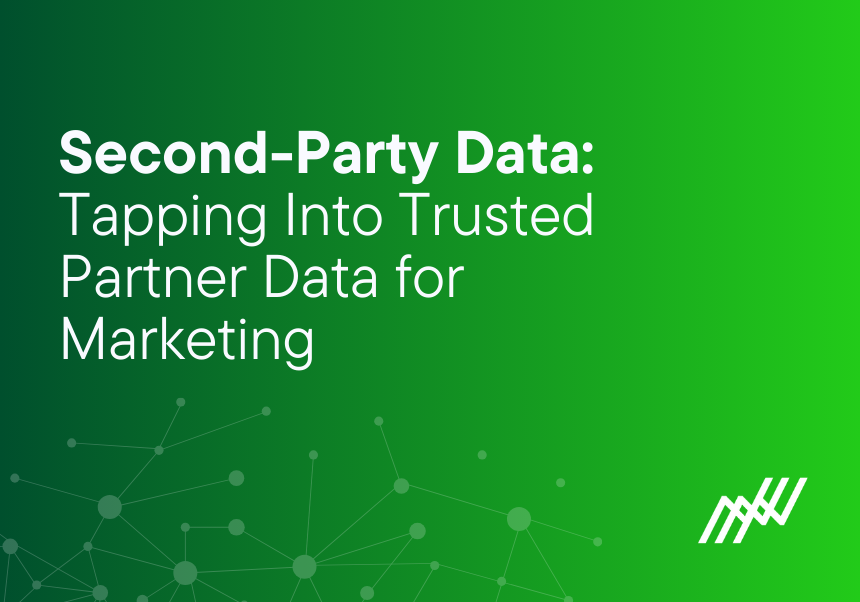
Second-Party Data: Tapping Into Trusted Partner Data for Marketing
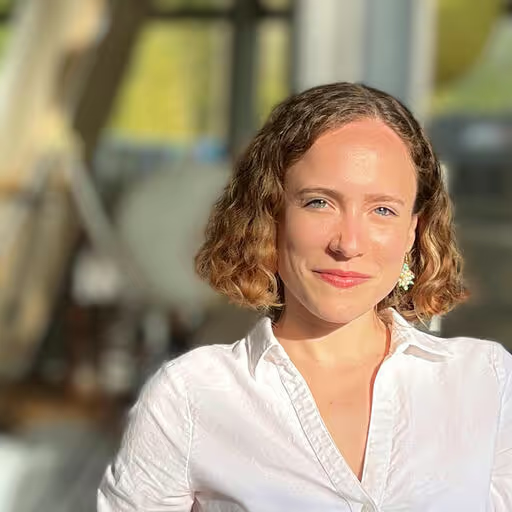
As privacy rules tighten and third-party cookies fade out, marketers are looking for reliable ways to reach the right people and measure what actually drives results; second-party data offers a practical path forward.
In this guide, we break down what second-party data is, why it matters, and how to integrate it into your performance and measurement workflows.
You’ll learn the core benefits, the steps to build a data partnership, how second-party data affects attribution accuracy, and the potential risks to watch for as you scale.
Most importantly, you’ll learn how to use partnerships to unlock better second-party audience data, clearer insights, and stronger returns with privacy top of mind.
What Is Second-Party Data & Why It’s Relevant
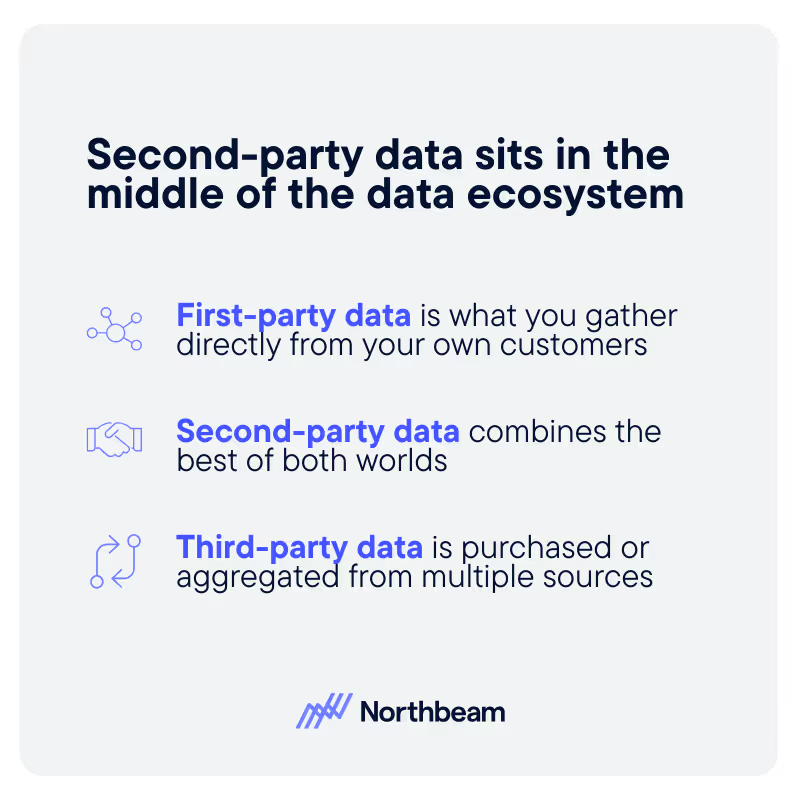
Second-party data is essentially another organization’s first-party data that you access through a direct, trusted partnership.
It sits in the middle of the data ecosystem:
- First-party data is what you gather directly from your own customers.
- Third-party data is purchased or aggregated from multiple sources and often loses fidelity along the way.
- Second-party data combines the best of both worlds.
You gain access to new audiences and behavioral signals, but with the clarity and provenance that third-party datasets typically lack.
This matters more than ever. With third-party cookies fading out and privacy regulations raising the bar on data governance, marketers need scalable ways to target effectively without compromising on accuracy.
From an attribution standpoint, the impact is even more meaningful. Higher match rates and cleaner identifiers reduce “unknown” traffic, improve funnel visibility, and help performance teams measure campaign outcomes with greater confidence.
In short, better data leads to better decisions, and second-party data delivers both the quality and context needed to get there.
Key Benefits & Use Cases of Second-Party Data
The benefits of second-party data partnerships center around new opportunities for marketers who want to scale intelligently while keeping data quality and governance front and center.
Here’s how to use second-party data for marketing campaigns:
Expanded Reach with Quality
Second-party partnerships give you access to high-intent audiences you wouldn’t reach on your own, without sacrificing signal quality.
Partner data comes with stronger identifiers, clearer consent, and more reliable behavioral signals. That makes it easier to target efficiently and avoid wasted spend.
Audience Enrichment and Lookalike Building
Because partner data often includes detailed attributes or engagement insights, it can enrich your existing segments and strengthen lookalike modeling. When your seed audiences improve, so does the performance of your acquisition campaigns.
Better Attribution and Journey Insight
Second-party data can fill critical gaps in your first-party view. If your customers interact with adjacent brands, publishers, or ecosystems before reaching you, partner data helps surface those touchpoints and clarify the full funnel path.
Co-Marketing and Shared Assets
Marketing data partnerships don’t stop at targeting. They enable joint campaigns, shared audience insights, and collaborative creative strategies. This can lead to lower acquisition costs, expanded brand equity, and a more unified customer experience across channels.
Competitive Advantage
Because many second-party relationships are exclusive or bilateral, they offer differentiation competitors can’t easily replicate. Access to unique, high-fidelity audiences often translates into better performance and a more resilient acquisition engine.
Framework for Acquiring & Deploying Second-Party Data

Here are the steps teams should follow to evaluate, integrate, and activate partner data with confidence.
Identify Complementary Partners
- Look for organizations whose audiences overlap with or complement your target customers, without being direct competitors.
- Clarify what types of data they hold (purchase behavior, loyalty activity, interest signals) and how those signals support your marketing objectives.
Negotiate Data Sharing Terms and Governance
- Establish clear contracts outlining what data will be shared, how it can be used, the duration of access, and all compliance requirements.
- Use clean rooms or secure data exchange frameworks when needed to preserve privacy and identity safety.
- Define usage rights, refresh cadence, success metrics, and reporting expectations upfront.
Technical Integration and Data Quality Checks
- Validate the partner’s data sources, formats, identifiers, segmentation logic, and match rates.
- Combine partner data with your first-party datasets (when privacy and consent allow) or use it to build new segment pools.
- Update your tracking and attribution systems so new data layers flow into audiences, measurement, and modeling.
Activate and Measure
- Build campaigns using second-party segments for bidding, enrichment, or lookalike expansion.
- Track performance against baseline first-party audiences to understand lift.
- Feed results back into attribution models to measure incremental conversions, ROAS impact, and reach extension.
Review and Iterate
- Continuously monitor how partner segments perform and whether their quality changes over time.
- Renew, expand, or replace partnerships based on results.
- Adjust your activation strategies (such as lookalike modeling or channel mix) using learnings from the pilot and ongoing performance.
Attribution & Performance Implications
Second-party data and attribution strategy can have an outsized impact on overall performance because they add clarity to parts of the customer journey that are normally opaque.
When you introduce partner-sourced identifiers and behaviors into your stack, match rates typically rise and audience definitions sharpen. That means fewer users fall into “unknown” buckets, giving your attribution models a more complete and accurate picture of how people move through the funnel.
This additional visibility matters most when partner data captures behaviors outside your usual domain.
If a customer engages with an adjacent brand or publisher before finding you, those touchpoints often disappear in a standard first-party view. With second-party data, you can track that interaction through to conversion and understand its true contribution to the path to purchase.
These new signals can also reshape how channels perform in your models. When previously invisible users become identifiable, conversion curves may shift, and channels that looked ineffective may reveal stronger influence.
It’s important to interpret these changes carefully. Not all improvements are inherently incremental, and partner audiences can introduce bias if left untested.
The most reliable approach is to use control groups, lift studies, or holdout tests to confirm the real, incremental impact of second-party data on performance.
Challenges, Risks, & Best Practice Considerations
Without valid consent frameworks, partner alignment, and proper documentation, even high-quality data can introduce legal and reputational risk.
Here are some challenges and best practices to consider:
Data Quality and Freshness
Partner data isn’t automatically reliable.
Audits are still essential to check for outdated records, inconsistent identifiers, or misaligned segmentation. Stale or noisy data can derail targeting, inflate acquisition costs, and lead to misleading insights.
Technical Integration Complexity
Integrating partner datasets requires precise matching logic, consistent identifiers, and alignment across schemas.
Attribution and analytics pipelines may need updates to properly ingest and model new data layers. Small mismatches can create major downstream errors.
Partner Misalignment
If the partner’s audience doesn’t overlap meaningfully with your target customers, performance will lag. Alignment should be evaluated early through audience comparisons, shared goals, and a clear understanding of what behaviors or attributes each side contributes.
Over-Dependence on a Single Partner
Relying heavily on one data partner can create operational and strategic vulnerability. Diversification reduces the risk of data degradation, partnership changes, or cost escalations affecting performance.
Elevated Governance Requirements
Second-party data should be governed with the same rigor as your first-party data. Maintain clear documentation, lineage tracking, quality standards, and dashboards that monitor performance and usage.
Strong governance ensures long-term reliability and trust across teams.
Case Study: Second-Party Data in Practice
Let’s see the value of second-party data by looking at how a consumer brand could partner with a publisher in an adjacent, non-competitive niche.
In this case, the publisher had a highly-engaged subscriber base with strong behavioral signals like content interests, purchase intent markers, and consistent on-site activity.
Through a direct data partnership, the brand gained access to a curated segment of these engaged users and used it to build targeted ad campaigns.
Once activated, the difference was immediate.
Match rates increased because the partner’s identifiers were clean and consented, and cost per acquisition dropped compared to the brand’s standard prospecting audiences.
In attribution reporting, the partner-derived segment converted at a materially higher rate and incremental ROAS outperformed baseline audiences by a meaningful margin. Those early signals gave the team confidence to scale spend and shift more budget toward the high-performing segment.
The full funnel told an even clearer story.
Partner data informed the audience build, the audience powered targeted ads and remarketing flows, and those campaigns fed clean, trackable conversions back into the attribution model.
That closed loop from data to activation to insight allowed the brand to refine strategy, allocate budget more efficiently, and grow performance with far greater precision.
Get Started with Second Party Data
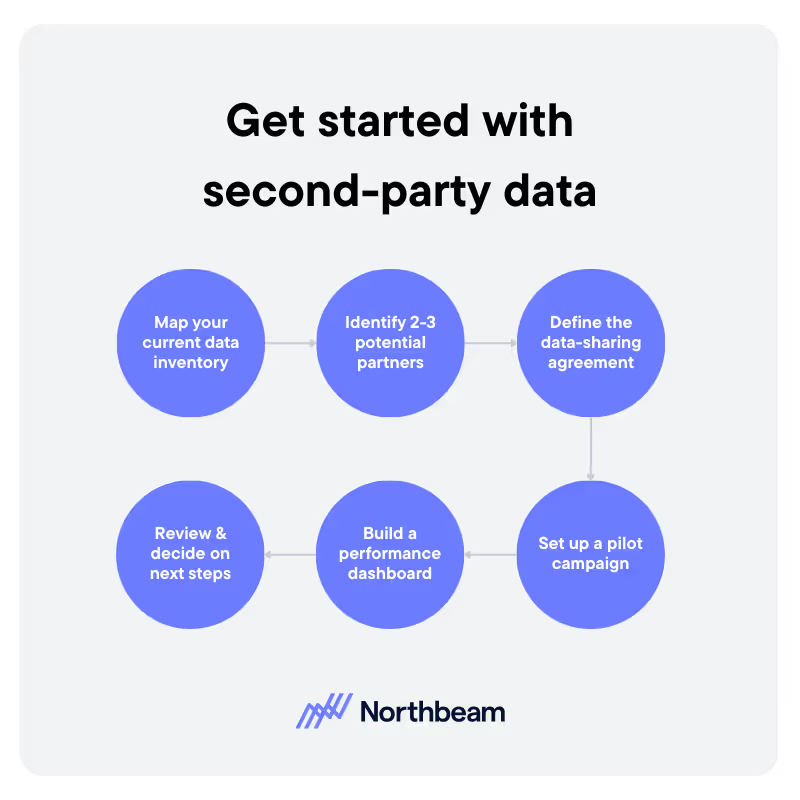
To help your team move from theory to execution, here are clear next steps for evaluating, piloting, and scaling a second-party data partnership:
- Map your current data inventory. List all first-party, third-party, and potential second-party sources to understand where partner data can add the most value.
- Identify 2-3 potential partners. Look for organizations whose audience signals align with your marketing objectives, and begin exploratory conversations about partner data sharing.
- Define the data-sharing agreement. Clarify what data will be exchanged, how it can be used, compliance requirements, usage rights, and the success metrics you’ll measure against.
- Set up a pilot campaign. Select one partner dataset, build an audience segment, activate it across your media stack, and measure performance relative to your baseline segments.
- Build a performance dashboard. Track metrics like match rate, conversion rate, CPA, incremental lift, and ROAS to understand real impact.
- Review and decide on next steps. After the pilot, determine whether to scale the partnership, refine the approach, or test a new partner, and document learnings to guide future work.
Taken together, these steps create a structured path for safely testing second-party data while building confidence in its long-term value.
Elevate Your Data Strategy
Second-party data gives marketing and attribution teams a powerful way to boost targeting accuracy, improve measurement, and expand reach without sacrificing governance or data quality.
By partnering with trusted organizations, you gain access to high-fidelity signals that strengthen modeling, clarify the customer journey, and unlock new performance opportunities. The key is to approach these partnerships with intention: from evaluating alignment and defining governance to testing, measuring, and iterating your way into a scalable strategy.
Used well, second-party data can become a durable advantage in an increasingly privacy-first world.
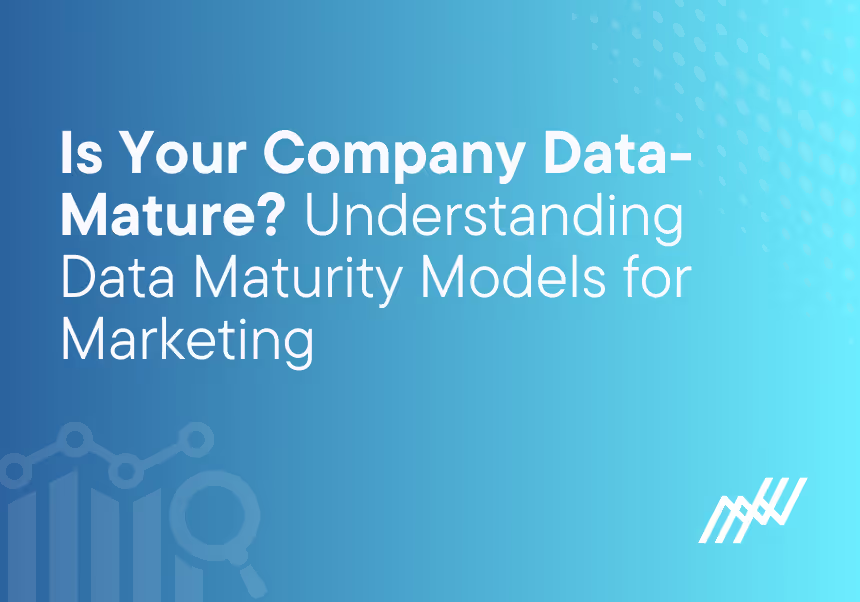
Is Your Company Data-Mature? Understanding Data Maturity Models for Marketing

Many marketing teams talk about being “data-driven,” but data maturity is a spectrum.
Some teams rely on basic reports pulled at the end of the month. Others operate with real-time insights, automated decisioning, and predictive models shaping strategy.
Understanding where your team falls on that spectrum, and how to move forward, is the core purpose of a marketing data maturity model.
In this guide, we’ll break down what “data maturity” means, the key dimensions that shape it, and the five stages most teams move through when moving from an ad-hoc to a data-mature marketing organization.
What “Data Maturity” Means for Marketing
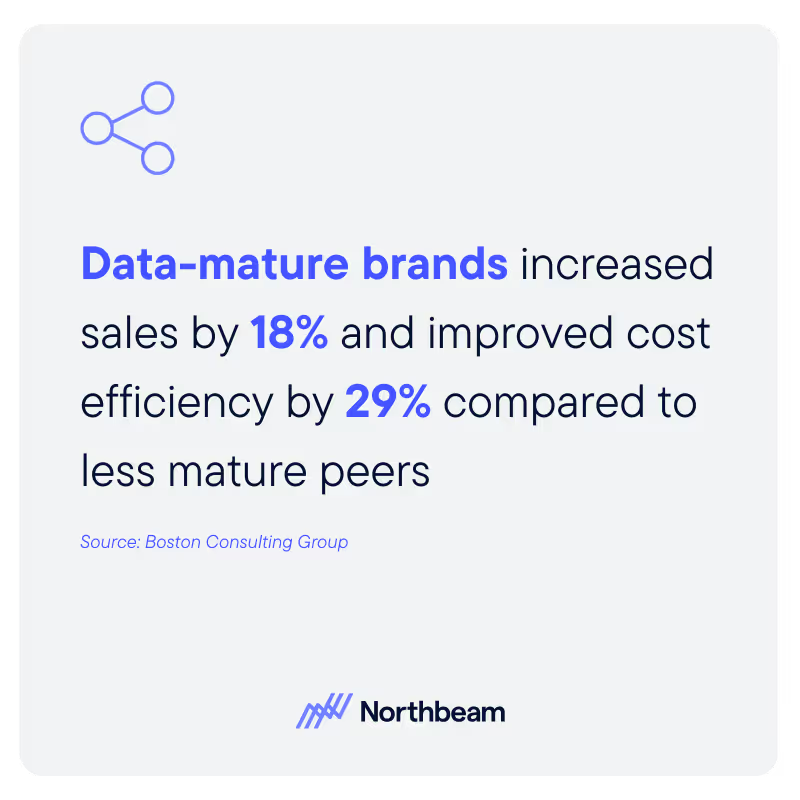
In a marketing context, data maturity reflects how effectively your team uses data to guide strategy, personalize outreach, optimize campaigns, and tie activity to measurable business outcomes.
Mature organizations don’t treat data as a reporting function. They use it as the connective tissue of their entire growth engine, from segmentation and creative testing to budgeting and lifecycle strategy.
The impact is tangible. Research from Boston Consulting Group (BCG) found that more digitally mature brands increased sales by 18% and improved cost efficiency by 29% compared to less mature peers.
In other words, data maturity is one of the clearest competitive advantages a marketing team can build.
Most teams can also recognize the early warning signs that they aren’t as data-mature as they’d like to be:
- Data lives in disconnected tools and channels
- Dashboards are isolated, inconsistent, or manually maintained
- Reporting depends on spreadsheets and heroic effort rather than repeatable systems
- Campaigns rely on gut instinct because insights are incomplete or hard to access
- Instead of measuring the full customer journey, teams focus only on surface-level metrics like clicks or impressions.
These patterns aren’t failures. They’re indicators of where you are today, and a starting point for building a more integrated, data-mature marketing organization.
Key Dimensions of a Data Maturity Model for Marketing Teams
To understand your level of data maturity, it helps to break the concept into core dimensions:
Strategy & Alignment
Data maturity starts with strategy and alignment. This means marketing KPIs are explicitly tied to business objectives, not created in isolation.
Mature teams work within a culture where data-informed decision-making is expected, shared, and reinforced, from leadership priorities to campaign planning.
Without this alignment, even the most sophisticated tools fail to drive meaningful outcomes.
Data Governance & Quality
Governance covers how your data is collected, cleaned, standardized, and maintained. High-maturity teams invest in master data management, ensure data accuracy and accessibility, and define processes that keep customer data trustworthy over time.
Data & Technology Architecture
Your marketing tech stack is only as powerful as the connections between its components.
Modern architecture enables cross-channel data flow, unifies event and customer data, and supports real-time analytics.
If tools operate in silos or require heavy manual intervention, insights will lag and opportunities will be missed.
Analytics Capability
Analytics maturity evolves in stages:
- Descriptive (what happened)
- Diagnostic (why it happened)
- Predictive (what will happen)
- Prescriptive (what to do next)
As teams progress, data becomes less about reporting and more about foresight. Mature organizations incorporate modeling, forecasting, and experimentation into everyday workflows.
People & Culture
Technology can only take an organization so far. Data-mature teams cultivate literacy across their marketing organization and beyond, encouraging experimentation, and promoting tight collaboration among marketing, analytics, product, and engineering.
On these types of teams, curiosity and cross-functional problem-solving become cultural norms.
Execution & Activation
Ultimately, maturity shows up in how well data fuels daily marketing activity.
This includes smarter segmentation, personalization at scale, rigorous measurement, consistent optimization, and campaigns that adapt in real time.
The most mature teams close the loop between insight and action quickly and repeatedly.
These six dimensions form the framework for assessing your current state and identifying where maturity improvements will have the highest impact.
Typical Stages of Marketing Data Maturity
Every marketing team sits somewhere on the data-maturity spectrum. Understanding your stage helps you benchmark your current capabilities and set realistic expectations for growth.

Most organizations fall into one of five broad categories:
Stage 1: Ad Hoc / Emerging
Teams at this stage rely on basic campaign metrics like impressions and clicks.
Data lives in channel-specific tools, reporting is inconsistent, and insights rarely influence strategy.
Most decision-making happens through intuition or past experience, making this the least scalable stage.
Stage 2: Developing / Building
Some unification begins to take shape in Stage 2. Teams might connect a few data sources or build early cross-channel dashboards.
Segmentation and personalization are possible but limited, often requiring manual effort. This is the stage where teams recognize the value of data but haven’t yet operationalized it.
Stage 3: Connected / Proactive
Data infrastructure becomes more robust and reliable in Stage 3. A shared customer view emerges, analytics begin driving decisions, and campaigns are optimized across channels rather than within silos.
Teams at this stage shift from reactive reporting to proactive insight generation.
Stage 4: Strategic / Data-Mature
In Stage 4, marketing becomes deeply integrated with predictive analytics, real-time optimization, and full-funnel measurement aligned to business outcomes.
Testing is systematic, insights flow quickly into activation, and data literacy is strong across the organization. This is where real competitive advantage becomes visible.
Stage 5: Optimized / Transformational
In Stage 5, marketing operates as a serious growth engine. AI, automation, and advanced modeling shape strategy at scale. Data is embedded into culture, not just tooling. Teams move with agility, adapting to customer behavior in real time and continuously learning from every interaction.
By identifying your stage, you can build a roadmap that’s ambitious but achievable. But how do you know exactly what stage you’re in now?
How to Assess Marketing Data Maturity
To assess your team’s data maturity, start by conducting a data-driven marketing maturity audit.
This involves scoring your team across each key dimension listed above:
- Strategy and alignment
- Data governance and quality
- Data and tech architecture
- Marketing analytics maturity
- People and culture
- Execution and activation
Give yourself a score for each dimension. The goal isn’t to produce a perfect number, it’s to reveal patterns and help you decide where to focus first.
Many teams pair this internal audit with external benchmarking. Frameworks from Gartner and other industry leaders offer structured questionnaires and maturity rubrics that help you calibrate your results against peers and best-in-class organizations.

To bring your assessment to life, visualize your scores. A radar chart or similar diagnostic view makes maturity gaps immediately visible and highlights where investment will drive the biggest lift.
Often, you’ll see that one or two lagging dimensions disproportionately drag down your overall maturity level.
Most importantly, conduct the assessment collaboratively. Involving stakeholders from marketing, analytics, IT, data engineering, and even leadership ensures you’re capturing the full picture.
It also creates early buy-in for the roadmap you’ll build next, because maturity transformation is rarely a marketing-only project. It succeeds when the entire organization is aligned around the same goals, the same metrics, and the same definition of “data-driven.”
Building the Roadmap to Data-Mature Marketing
An assessment becomes meaningful once it turns into action.
After identifying your strengths and gaps, the next step is to build a phased roadmap that moves your organization toward greater data maturity in a realistic, sustainable way.
Start with Quick Wins
These are low-effort, high-impact improvements that unlock immediate value.
Examples include:
- Unifying a few high-value data sources
- Standardizing naming conventions or taxonomies
- Building or refreshing core dashboards
- Implementing basic segmentation or journey mapping
- Eliminating manual reporting bottlenecks
Move to Medium-Term Initiatives
These require more coordination and investment, but fundamentally upgrade your marketing operations.
Common examples:
- Expanding or modernizing your marketing tech stack
- Implementing a customer data platform (CDP)
- Enabling real-time analytics pipelines or event tracking
- Formalizing experimentation processes
- Upskilling teams and reinforcing a data-driven culture
- Improving collaboration between marketing, analytics, and engineering
Plan for the Long-Term
These initiatives help you reach full data maturity and create a scalable, self-optimizing marketing engine.
They often include:
- Predictive modeling and forecasting
- Advanced attribution and measurement
- Automated decision-making
- Personalization at scale across channels
- AI-driven optimization
Tie Initiatives to Business Outcomes
Align your roadmap with measurable company goals such as:
- Lower customer acquisition cost (CAC)
- Improved retention or customer lifetime value (LTV)
- Faster experimentation cycles
- Increased marketing-influenced revenue
Establish Governance and Operating Models
To ensure maturity isn’t a one-off project, define:
- Data ownership and stewardship
- Processes, documentation, and QA standards
- Recurring maturity audits and alignment rituals
Measure Maturity Improvements Over Time
Track indicators like:
- Percentage of campaigns using data-driven segmentation
- Time from insight to action
- Cost per test or experiment
- Percentage of decisions backed by data
Challenges & Considerations for Marketing Leaders
Even with a clear roadmap, progressing through the stages of data maturity isn’t always straightforward.
Most teams encounter predictable obstacles that can slow down momentum or create false signals of progress. Being aware of these challenges upfront helps leaders navigate them with more intention and fewer surprises.
Data Silos
When channels, tools, or business units operate in isolation, insights stay fragmented and teams lose the ability to understand the full customer journey.
Resource Constraints
Many organizations underestimate the talent required to operationalize data maturity. It’s not just the tools, it’s analysts, engineers, and marketers who can translate data into meaningful action.
Tech Before Culture
A shiny new tool can’t compensate for misaligned processes or a culture that doesn’t value experimentation and data-driven decision-making. Culture and operations must mature alongside the stack.
Misaligned Expectations
Moving from Stage 1 to Stage 4 isn’t a quick win. It requires sustained investment, organizational alignment, and a willingness to change how decisions are made.
Privacy & Ethical Considerations
As personalization becomes more sophisticated, compliance, consent, and responsible data use become non-negotiable components of maturity.
“Maturity Theater”
It’s easy to claim advanced capabilities without the underlying systems to support them. True data maturity is demonstrated through measurable impact, not labels.
With these challenges in mind, leaders can approach maturity work with clearer expectations and a more grounded path forward.
Case Study: How One eCommerce Brand Leveled Up Its Data Maturity
Consider a mid-size ecommerce brand operating squarely at Stage 2 of data maturity.
Their marketing efforts were spread across disconnected tools, each channel measured in isolation. Without a unified customer view, the team relied on surface-level metrics like clicks, opens, and last-touch attribution.
Their campaigns performed reasonably well, but growth had stalled; they couldn’t see what was working across the full customer journey.
To move forward, the team implemented a customer data platform (CDP) and consolidated cross-channel tracking.
They defined a shared set of KPIs, aligned stakeholders around a unified measurement framework, and rebuilt core dashboards to reflect customer-level behavior rather than channel-level outputs.
Within a quarter, the shift was clear.
Reporting evolved from “clicks only” to dark-funnel attribution and multi-touch insights. Campaigns moved from one-off initiatives to journey-based optimization, and tests scaled faster because the team could finally see which touchpoints drove incremental value.
These improvements lifted ROI, shortened the time from insight to action, and moved the organization firmly into Stage 3: Connected and Proactive.
Start Your Maturity Journey Today
Reaching higher levels of data maturity doesn’t require a massive transformation from day one. Small, structured steps can create meaningful momentum and help your team build confidence along the way.
Here is a quick checklist to help you get started:
- Host an internal workshop with stakeholders from marketing, analytics, IT, and data engineering. Use the maturity dimensions outlined in this guide to score your current state and surface gaps or inconsistencies.
- Identify three priority initiatives: one quick win, one medium-term improvement, and one long-term capability. Assign clear owners, timelines, and success metrics so each initiative has a path to execution.
- Build a maturity dashboard to track your progress. Useful indicators like the percentage of campaigns using insights, time from insight to activation, or the share of marketing spend influenced by data.
- Establish a quarterly review cadence to revisit your maturity score and evolve your roadmap.
Marketing data maturity isn’t static. It’s a continual process of strengthening foundations, refining processes, and expanding capabilities.
Every step forward compounds, and the brands that invest steadily unlock a clear advantage.

Follow us


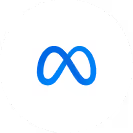











.svg)
